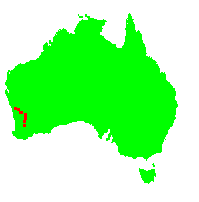General Description:
Eucalyptus synandra is uncommon in the wild and in cultivation. It is a tall shrub or small tree of mallee (multi-stemmed) habit) growing up to 5-6 metres tall. The leaves are linear to narrowly elliptic in shape about 200 mm long. The smooth bark is greyish and is shed annually. Flowers are very conspicuous and are initially white but age to deep pink or red with the stamens being united into a tube for the lower portion of the flowers. Flowering occurs in late spring and summer.
To date this species has not been cultivated to any great extent, however, this is certain to change as the plant becomes better known. It is a spectacular small tree for drier climates, ideally suited to average sized gardens. Its suitablity for more humid areas is not known but may be expected to present a challenge (which would certainly be worth the effort). The plant appears to be reasonably cold-tolerant and has flowered at the Australian National Botanic Gardens in Canberra. Soils with reasonable drainage are preferred.
A feature of the plant is that it is probably the most precocious of all the eucalypts, sometimes flowering when only 15 cm tall.
Propagation is from seed which germinates readily.
* EPBC Act = Environment Protection and Biodiversity Conservation Act 1999;
ROTAP = Rare or Threatened Australian Plants (Briggs and Leigh, 1988)
For further information refer the Australian Plants at Risk page

Eucalyptus synandra
Photo: Graeme O’Neill
 Australian Native Plants Society (Australia)
Australian Native Plants Society (Australia)